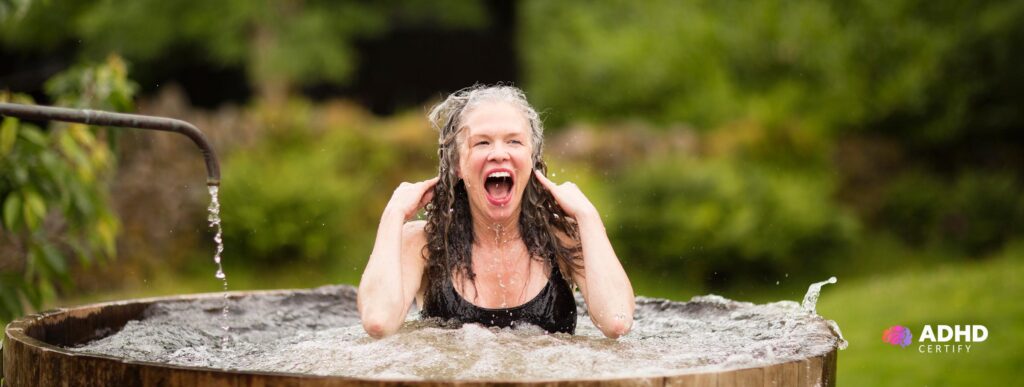In England, around 3–4% of adults are estimated to have ADHD, that is roughly 1.9 million people, yet many remain undiagnosed and unsupported.
Picture this: a busy morning, your mind racing, focus slipping, and the day ahead already feeling like a mountain.
What if plunging into icy water could offer a powerful reset?
For adults with ADHD, parents of teens managing the daily challenges, wellness seekers and biohackers alike, the benefits of ice baths for ADHD are gaining traction.
Cold plunge routines are no longer fringe, they’re being explored for their potential to improve focus, regulate mood and support better sleep.
Some even refer to them as an ADHD dopamine reset in motion. Ice bath therapy ADHD may sound extreme, but the science is warming up, and the stories behind it are compelling.
Could cold exposure truly become one of the most accessible ADHD focus improvement hacks?
Before we discuss the reasons why you should try an ice bath, let’s understand;
Cold Therapy, Ice Baths, or Cold Showers: What’s the Difference?
- Cold therapy is the umbrella term that includes any form of intentional cold exposure.
- Cold showers are the most accessible form, often used as a starting point.
- Ice baths involve full-body immersion in cold water and are more intense.
Each method stimulates the nervous system differently, but all can support ADHD management when used safely.
12 Reasons Ice Baths May Help With ADHD
Wondering how cold exposure helps with ADHD? These 12 benefits of ice bath therapy break it down.
1. Improves Focus and Attention
Many people report a sharp mental clarity after a cold plunge. This may be due to the sudden activation of the sympathetic nervous system, which can temporarily enhance alertness and concentration.
For those with ADHD, this spike in attention might offer a short-term cognitive boost.
Cold plunge ADHD focus routines are becoming popular among people looking for non-pharmacological ADHD focus improvement hacks.
2. Enhances Mood and Emotional Regulation
Cold exposure can trigger a flood of endorphins and activate brain regions involved in mood regulation. This might explain why people often feel euphoric or emotionally reset after an ice bath.
For individuals with ADHD, who may experience emotional reactivity, this boost could be helpful in smoothing emotional highs and lows.
It’s one of the emerging cold exposure ADHD benefits gaining attention in the ADHD community.
3. Reduces Impulsivity
The self-discipline required to stay in icy water, even for a minute, is no small thing. Training the body to remain calm during discomfort may carry over into daily life, reducing impulsive reactions.
This makes ice bath therapy ADHD-friendly not just for focus, but also for behavioural control.
4. Builds Stress Resilience
Cold water exposure puts the body into a controlled stress state. Over time, regular exposure can train the nervous system to tolerate stress more effectively.
For people with ADHD, who may be more sensitive to stress and overstimulation, this can offer a powerful tool to build emotional and physiological resilience.
5. Reduces Anxiety and Depression Symptoms
There’s growing interest in cold therapy as a way to manage mood disorders. For those with ADHD, who often experience comorbid anxiety or depression, the mental shift post-plunge can be substantial.
This is partly due to increased levels of norepinephrine and endorphins, which help stabilise mood and reduce mental fog.
6. Improves Sleep Quality
Ice baths may help regulate circadian rhythms by reducing cortisol and promoting parasympathetic recovery. Better sleep isn’t just a wellness perk, it’s critical for ADHD symptom management.
People report falling asleep faster and feeling more rested after incorporating cold exposure into their evening routines.
7. Lowers Inflammation
Cold exposure has been shown to reduce systemic inflammation, lowering markers like CRP and pro-inflammatory cytokines.
Since ADHD and inflammation are increasingly linked, dipping into ice baths could help clear the mental haze tied to inflammatory pathways.
8. Promotes Neurotransmitter Balance (Dopamine & Norepinephrine)
Brief cold plunges spike norepinephrine by 530% and dopamine by about 250%. Both of these chemicals are key in ADHD, meaning an ADHD dopamine reset may be achieved naturally through ice bath therapy for ADHD.
9. Train Nervous System Flexibility
Cold water immersion prompts a “neurohormesis” effect, a controlled stress exposure that trains your nervous system to adapt. For ADHD, this could translate to smoother regulation between high-alert and calm states.
10. Provides a Natural “Reset” for the Mind and Body
A quick cold plunge interrupts mental spirals by forcing bodily focus. Research links immersion to improved functional brain connectivity tied to attention and emotion systems, a natural reset without medication.
11. Increases Energy and Motivation
Cold exposure triggers epinephrine and norepinephrine surges, boosting alertness and drive. That rush can feel like a clean energy shot, especially useful for anyone seeking ADHD focus improvement hacks.
12. Offers a Holistic, Accessible Tool for ADHD Management
Ice baths are relatively low-cost, require no prescription and can be tailored to individual tolerance. While not a replacement for medical treatment, they fit into a broader strategy for ADHD management that includes diet, movement, mindfulness and sleep.
For many, they represent a rare win: simple, effective, and within reach.
And, the benefits of ice baths are not only limited to people with ADHD, but there is also a buzz in the Autism community as well, where ice baths are regarded as “Intense and Predictable Input for a Dysregulated Nervous System”.
What the ADHD Community Is Saying About Ice Baths
Curious what people with ADHD say about cold plunges?
Here’s what the community is sharing about ice bath therapy for ADHD.
Insights from Reddit and ADHD Forums
The ADHD community is buzzing with cold exposure experiments. On r/ADHDUK, one user shared:
- “Ice baths or cold dips are 1000 % more effective when done first thing in the morning… I go into work with this unbridled zest for life”.
- Another on r/HubermanLab concluded:
“Cold showers may boost dopamine and norepinephrine which is also what many ADHD drugs do… it probably isn’t a full replacement for meds”.
These conversations echo growing interest in ice bath therapy for ADHD as a natural boost.
Real-Life Experiences and Cold Plunge Anecdotes
Stories from r/ADHD highlight powerful personal impacts. One member noted a cold shower routine reduced mental races and improved clarity without medication. Others describe “a full system reboot” after a plunge.
Many weave cold exposure into daily rituals often before work, as an ADHD focus improvement hack.
Common Benefits and Cautions Shared Online
Frequent themes include enhanced focus, energy, mood and better emotional awareness, especially early in the day. But some users warn it is not universal.
A participant from r/AutisticWithADHD wrote: “It is absolutely terrible with no positive effects on me.
And those with certain health conditions advise caution. Online wisdom encourages starting slow and tuning in to how your body responds.
Wim Hof Method for Gradual Cold Exposure
The Wim Hof Method revolves around cold showers or gradual cold therapy. The gradual cold exposure offers practical steps for people with ADHD who need a slower, more sensory-aware approach.
Breathwork, short rinses, and partial immersion are all techniques shown to reduce overwhelm and improve tolerance, especially for those with heightened sensitivity or co-occurring conditions.
How to Safely Use Ice Baths for ADHD
Before you try ice bath therapy for ADHD, here’s how to do it safely, effectively and with confidence.
Getting Started: Frequency and Temperature
Start with cold plunge ADHD focus sessions twice weekly, ideally in the morning. Aim for water temperatures around 10–15 °C and stay in for 20 seconds in the beginning.
As tolerance builds, you can gradually increase to 1 minute or more.
Safety Considerations and Contraindications
Ice baths are powerful stressors. Avoid if you have cardiovascular issues, uncontrolled blood pressure, Raynaud’s or epilepsy. Always exit if you feel numb, dizzy or deeply uncomfortable.
Consulting a medic before starting is wise, especially if you’re on ADHD medication or have chronic conditions.
Pairing Ice Baths with Breathwork or Mindfulness
Combining cold exposure with controlled breathing enhances results. Focused inhalation during the plunge can calm the sympathetic response and support emotional regulation. Many ADHD users describe this combo as a reboot that both soothes and sharpens the mind.
Should Ice Baths Replace ADHD Medication?
No. Community consensus is clear: cold therapy is a complement, not a replacement.
Reddit discussions agree that cold showers can boost outcomes, but they are not a substitute for prescribed treatment. Use them alongside medication, therapy and lifestyle practices, not instead of them.
Final Thoughts:
The question of why ice baths help ADHD is starting to find clearer answers.
From brain chemistry to nervous system training, the evidence and lived experience suggest that cold exposure is more than just a wellness fad. It’s a low-barrier, drug-free ritual that could complement the way you manage focus, mood and energy.
Whether you’re a parent supporting a teen or an adult exploring new tools for attention and emotional regulation, the benefits of ice baths for ADHD speak to something many of us crave; clarity, calm and control.
That said, ice bath therapy for ADHD isn’t a silver bullet. Think of it more like a dial you can fine-tune alongside other tools. If you’re considering adding cold exposure to your routine, pair it with guidance that’s grounded in real diagnosis.
Services like ADHD Certify offer both child and adult ADHD assessments, plus a free online screening test for those just starting their journey.
Tried, tested and icy; a regular cold plunge may not cure ADHD, but it just might give your brain the reset it needs.
Frequently Asked Questions
Are ice baths scientifically proven to help with ADHD symptoms?
No, ice baths are not yet scientifically proven to treat ADHD directly. However, research from UK and global universities shows that cold exposure increases dopamine and norepinephrine, brain chemicals targeted by ADHD medications. These findings support why many people use ice bath therapy for ADHD as a supplementary focus and mood tool.
While the evidence is promising, more clinical trials specific to ADHD are needed.
Why not shower after an ice bath?
Jumping into a hot shower right after an ice bath can shock the body. The sudden temperature swing may interfere with natural rewarming, strain circulation and dull some of the benefits of the cold exposure itself.
Instead, warm up gradually with layers or gentle movement to allow your core temperature to stabilise safely.
How often should you take an ice bath for ADHD benefits?
Start with two to three ice baths per week, at a temperature of 10–15 °C for 1–2 minutes. As tolerance builds, increase to 5 minutes. Mornings are ideal for boosting alertness and clarity, while evenings may support better sleep. Listen to your body and avoid overexposure, consistency is more important than intensity.
Are there any risks or side effects of using ice baths for ADHD management?
Yes. While the benefits of ice baths for ADHD are widely discussed, risks include hypothermia, dizziness and blood pressure changes. People with heart conditions, Raynaud’s, epilepsy or circulation issues should avoid cold plunges unless cleared by a doctor.
Shivering, numbness and difficulty rewarming are signs to stop immediately. Cold therapy should support your routine, not overwhelm it.




